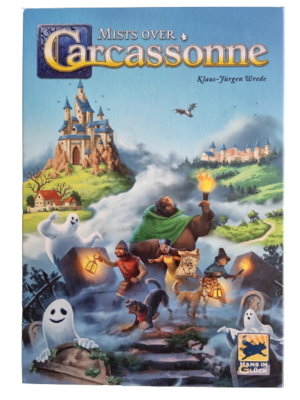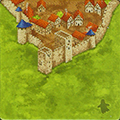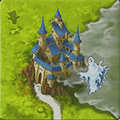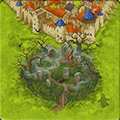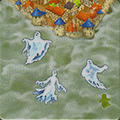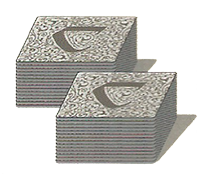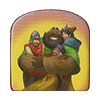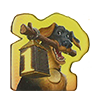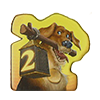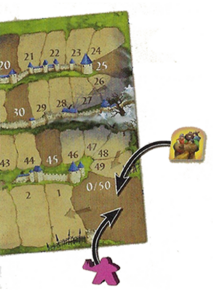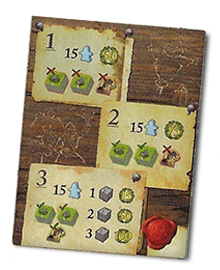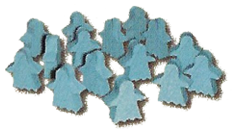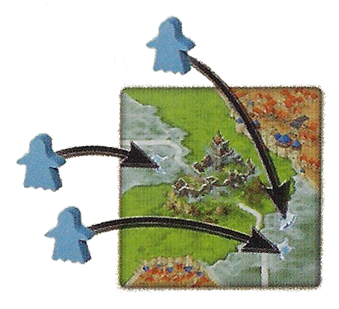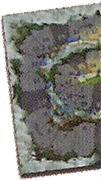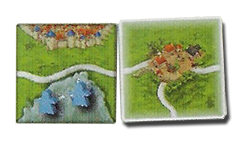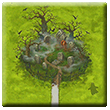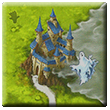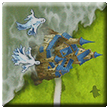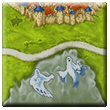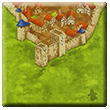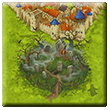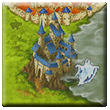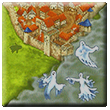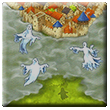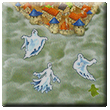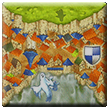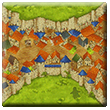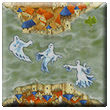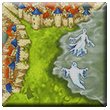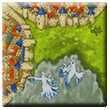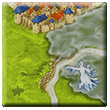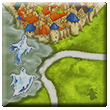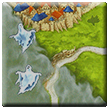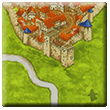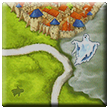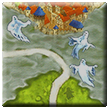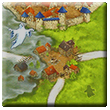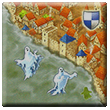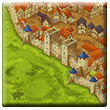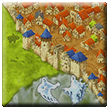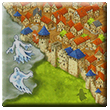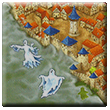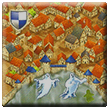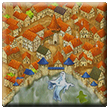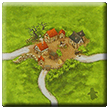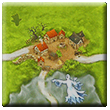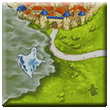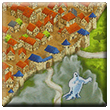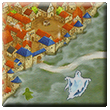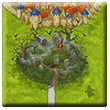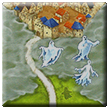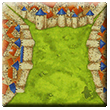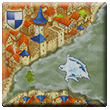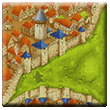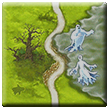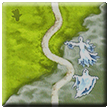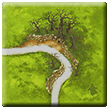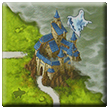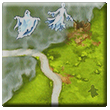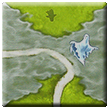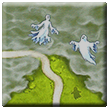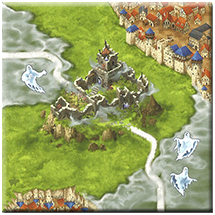Mists over Carcassonne Base Game
General info and comments
Originally released by Hans im Glück in 2022. Can be played standalone as a co-operative game, or together with the base game as Exp. 11 - Ghosts, Castles & Cemeteries.
Welcome to Mists over Carcassonne! Here we will introduce you to the first cooperative game in the world of Carcassonne. If you already know how to play Carcassonne, then these rules will be even easier for you. We have divided the game into 6 exciting levels, which you must master together. First, we'll explain the basic structure of game using Level 1 as an example. You'll find the explanations for the other levels starting here.
Components and setup
First, let's look at the LAND TILES. The 60 land tiles picture roads, cities, castles, and cemeteries.
Additionally, most of the land tiles show mist. You will always find one or more ghosts in the mist, that you must pacify during the game. We will explain more about ghosts later.
First, place the new starting tile, as shown, in the middle of the table. For Level 1, return all 5 cemeteries and all 5 castles to the box. Shuffle the remaining land tiles and place them in a facedown supply on the table, so that everyone can reach them. [1]
Note: Setup for the other levels is a bit different as indicated below.
Take the scoring track and place it near the edge of the table.
Place the level summary next to the scoring track. This will show you which tiles you need (or not), and how many points you need to reach each level.
For Level 1, that's 50 points. Place the goal token on the 0/50 space on the scoring track. Return the 2 hounds to the game box.
Now, let's look at your playing pieces (meeples, i.e. 'my people'). These represent your followers. They are a bit different from those in the base game and are called 'guard meeples', but for these rules we'll just refer to them as meeples. There are a total of 30, 5 in each color: red, green, blue, yellow, black and pink.
| Guard meeples |
Give each player (including yourself) 5 meeples in their chosen color. These form each player's supply. Then, place 1 meeple in an unchosen color onto the 0/50 space on the scoring track. This is your scoring meeple. Return the rest of the meeples to the box.
Finally, place 15 ghosts as a general supply next to the scoring track. Place 3 of the ghosts on the ghost symbols shown on the starting tile.
Object of the game
Players take turns, adding a new land tile to the board each time. This creates an expanding game board on which you place your meeples to score points. During the game, ghosts will keep appearing — your job is to pacify them. Together, you must reach the goal token, i.e. score a certain number of points depending on the level. But watch out: If there are too many ghosts on the board, or you can't draw any more land tiles, then you have lost. All players play together against the game. Show each other your tiles and decide as a team where to place them. Especially in later levels, you will need to cooperate well!
![]() Question: How do we win the game?
Question: How do we win the game?
Answer: Reaching goal tile.
In order to win the game, you must advance your scoring meeple to reach the goal tile,
which is placed on a specific space during game setup. (Dized.MoC.0060)
![]() Question: What causes us to lose the game?
Question: What causes us to lose the game?
Answer: Ghost or tile supply.
You lose the game when you run out of ghosts or tiles in the supply: when you must place
a ghost or a tile but you cannot, you immediately lose the game. (Dized.MoC.0059)
Gameplay
Play in clockwise direction. Whoever is reading these rules is the start player. Each turn, you must execute a set of actions in a specific order. We will explain as if you are doing everything; you can then explain it to your fellow players. Any details about the following actions will be explained later in the rules, when they become relevant.
1. Place a new land tile
| You must draw exactly 1 new land tile from the facedown supply and place it with at least one edge adjacent to an existing tile. [2] |
2. Place ghosts and meeple
| If the tile just placed has mist on it, you must take care of the ghosts (see details below). You may then place exactly 1 meeple from your supply on the tile just placed. |
![]() Question: Who is the 1st player?
Question: Who is the 1st player?
Answer: You are.
Whoever is reading this FAQ entry is the start player. (Dized.MoC.0057)
![]() Question: Can I refuse drawing or placing 1 land tile on my turn?
Question: Can I refuse drawing or placing 1 land tile on my turn?
Answer: No.
On each of your turns, you must draw and place exactly 1 land tile. (Dized.MoC.0056)
![]() Question: Can I show a tile I have drawn (but not yet placed) to other players?
Question: Can I show a tile I have drawn (but not yet placed) to other players?
Answer: Yes.
You should show each other your tiles and decide as a team where to place them. (Dized.MoC.0058)
![]() Question: Does the new tile I place have to touch another tile orthogonally (as opposed to touching diagonally)?
Question: Does the new tile I place have to touch another tile orthogonally (as opposed to touching diagonally)?
Answer: Yes.
When you place a new land tile, you must place it so it touches at least 1 other tile with
one of its sides (orthogonally). It is not enough for the tile to touch another tile with a corner (diagonally). (Dized.MoC.0052)
![]() Question: Do I have to place my meeple on a land tile I have just placed?
Question: Do I have to place my meeple on a land tile I have just placed?
Answer: No.
After placing a land tile, you may OPTIONALLY place 1 meeple from your supply on this
tile. (Dized.MoC.0055)
![]() Question: Can I place a meeple on a land tile, which was placed on an earlier turn?
Question: Can I place a meeple on a land tile, which was placed on an earlier turn?
Answer: No.
You may only place your meeple on the new land tile, which you have placed this turn. (Dized.MoC.0054)
![]() Question: Can I place several meeples in a single turn?
Question: Can I place several meeples in a single turn?
Answer: No.
You may place up to 1 meeple on your turn. (Dized.MoC.0053)
Roads
1. Place land tile
2. Place a meeple
After placing the land tile, you may place a meeple onto one of the tile’s roads. However, that is only allowed if the road is still unoccupied.
It is then the next player's turn. They draw a land tile and add it to the board. There is a meeple on the right-hand road coming into the village. Your fellow player therefore cannot place a meeple on it. So they decide to place their meeple on the other road of the tile just placed.
3. Score points
Whenever a road is closed at both ends, it counts as completed and triggers a scoring (e.g. when a road ends in a village, city, or loops back onto itself).
When a road is completed, it is scored. In this example, your fellow player placed the tile that completed the road with your meeple on it. Each tile of the completed road is worth 1 point. Since this road is 3 tiles long, it is worth 3 points.
Now the scoring track comes into play. It tells you what you need to reach with your remaining tiles. Each time you score, this goal gets closer.
Since your fellow player triggered the scoring, they move the scoring meeple 3 spaces forward on the scoring track. Finally, retrieve your meeple from the completed road, returning it to your supply.
![]() Question: Can I place my meeple on a road, which is already occupied by another meeple?
Question: Can I place my meeple on a road, which is already occupied by another meeple?
Answer: No.
You may only place your meeple on an unoccupied road. (Dized.MoC.0051)
![]() Question: Can another player finish a road with my meeple on it and trigger a scoring?
Question: Can another player finish a road with my meeple on it and trigger a scoring?
Answer: Yes.
Whenever a road is completed, its scoring is triggered immediately, regardless which
player's turn it is now. (Dized.MoC.0050)
![]() Question: How many points does a completed road provide?
Question: How many points does a completed road provide?
Answer: 1 point per tile.
Each tile a completed road is on is worth 1 point. (Dized.MoC.0049)
![]() Question: Can I take back my meeple from an unfinished road?
Question: Can I take back my meeple from an unfinished road?
Answer: No.
Your meeples return to your supply only when you complete a road the meeples
are on. (Dized.MoC.0047)
You now understand the most important parts of the game. That wasn't hard at all, right? Let's now look at the other feature types:
Cities
1. Place land tile
2. Place a meeple
3. Score points
Let's fast forward a bit and assume that you drew this tile on your next turn. Since the edges match, you can add it to the city with your meeple in it. Once a city is completely surrounded by city walls, it is completed. That is the case here. Since you have a meeple in this city, you now score it.
Each tile of the completed city is worth 2 points. Additionally, each coat of arms in the city is worth 2 additional points. After scoring, return the meeple from the city to your supply.
![]() Question: Can I place my meeple in a city, which is already occupied by another meeple?
Question: Can I place my meeple in a city, which is already occupied by another meeple?
Answer: No.
You may only place your meeple in an unoccupied city. (Dized.MoC.0051)
![]() Question: Can another player finish a city with my meeple on it and trigger a scoring?
Question: Can another player finish a city with my meeple on it and trigger a scoring?
Answer: Yes.
Whenever a city is completed, its scoring is triggered immediately, regardless which
player's turn it is now. (Dized.MoC.0050)
![]() Question: How many points does a completed city provide?
Question: How many points does a completed city provide?
Answer: 2 points per tile.
Each tile the finished city is on is worth 2 points. (Dized.MoC.0048)
![]() Question: Can I take back my meeple from an unfinished city?
Question: Can I take back my meeple from an unfinished city?
Answer: No.
Your meeples return to your supply only when you complete a city the meeples
are in. (Dized.MoC.0047)
![]() Question: How many points does a coat of arms in a completed city provide?
Question: How many points does a coat of arms in a completed city provide?
Answer: 2.
Each coat of arms in a completed city is worth 2 points. (Dized.MoC.0046)
![]() Question: Can I gain points from coats of arms without completing a city?
Question: Can I gain points from coats of arms without completing a city?
Answer: No.
Coats of arms provide points only when you complete a city the coats of arms are in. (Dized.MoC.0045)
Mist and the Ghosts
1a. Place land tile
As always, draw a tile to add to the board. This tile shows mist in addition to the road. Mist always covers a field or a road, never a city.
As usual, you must place the tile such that road matches road and field matches field. When doing so, you do not need to worry about the mist. In other words, you can place a misty road next to a clear road, or the other way around. The same counts for misty fields.
1b. Check mist
Now, check to see if a mist bank has been completed. Mist counts as completed when it is closed on all sides (i.e. there is no way to make it larger — this works in the same way as with a city).
It can never be completed as soon as one side is next to a field or road without mist.
If you completed a mist bank, remove all ghosts from the associated mist, returning them to the general supply. We'll explain how the ghosts got there in the first place now.

![]() Question: If we place a tile which completes a mist area, do we have to place ghosts first and immediately eliminate them afterwards?
Question: If we place a tile which completes a mist area, do we have to place ghosts first and immediately eliminate them afterwards?
Answer: When you complete a mist area, you do not need to place ghosts, you eliminate all ghosts. [6] (11/2022)
2a. Place ghosts
If the mist bank is not completed, place as many ghosts on the tile you just placed as there are ghost symbols on it.
If you expanded at least one mist bank (i.e. matched at least one edge of the tile you just placed with mist already on the board), then you place one fewer ghost on the tile. If the tile only shows a single ghost, then you don't need to place any ghosts.
Ghost supply
Important: If, at any time, there are fewer ghosts left in the supply than you need to place on a tile, you immediately lose the game.
2b. Place a meeple
You can never place a meeple onto mist. You may, however, place one onto a unoccupied road or city on the tile, as usual (or, in later levels, in a castle). [7]
3. Scoring: Points or remove ghosts
You may complete mist banks, but they never trigger a scoring (as described above, you remove ghosts instead). However, placing a tile can also trigger a scoring as usual.
If the tile you just placed — regardless of whether it has mist on it — triggers a scoring, you always have 2 options:
- Either score the points as usual.
- Or remove up to 3 ghosts from exactly 1 tile of your choice, returning them to the supply.
Special case: When a single tile triggers more than one scoring, the active player decides what happens for each scoring separately.
![]() Question: I skip scoring to remove ghosts and choose the starting tile. Do I remove all ghosts from the entire starting tile?
Question: I skip scoring to remove ghosts and choose the starting tile. Do I remove all ghosts from the entire starting tile?
Answer: No.
When you choose to remove ghosts from a land tile (instead of scoring), you may choose any regular-sized tile the starting tile represents and remove the ghosts from it. But you cannot remove ghosts from the entire starting tile with a single action this way. [8] (Dized.MoC.0002)
![]() Question: Can I place a tile so that a misty road or field touches a regular road or field?
Question: Can I place a tile so that a misty road or field touches a regular road or field?
Answer: Yes.
When placing a tile you must place the tile such that road matches road and field
matches field, meanwhile mist is ignored when considering tile placement restrictions. (Dized.MoC.0044)
![]() Question: Can we finish a mist bank, if its side is touching a regular field or road?
Question: Can we finish a mist bank, if its side is touching a regular field or road?
Answer: No.
A mist can never be finished as soon as one side is next to a field or road without mist. In order to finish a mist you must completely surround with edges of the mist, just like a city. (Dized.MoC.0043)
![]() '
'
![]() Question: Do I have to place a ghost, if I expand a mist bank with a tile, which shows only 1 ghost?
Question: Do I have to place a ghost, if I expand a mist bank with a tile, which shows only 1 ghost?
Answer: No.
If you expand at least one mist bank when placing a tile (i.e. matched at least one side of the tile you just placed with mist already on the board), then you place one fewer ghost on the tile. If the tile only shows a single ghost, then you don’t need to place any ghosts. (Dized.MoC.0041)
![]() Question: Can I place a meeple onto a mist bank?
Question: Can I place a meeple onto a mist bank?
Answer: Not directly.
You can never place a meeple directly onto mist. You may, however, place one onto a
clear road or city on the tile, as per usual (or, in later levels, into a castle). (Dized.MoC.0040)
![]() Question: Can I score mist banks?
Question: Can I score mist banks?
Answer: No.
While you can finish mist banks, they never trigger a scoring (you remove ghosts instead).
However, placing a tile with mist can also trigger the scoring of roads and cities in the usual manner.
(Dized.MoC.0039)
![]() Question: How many ghosts can I remove from a tile, when I forfeit scoring?
Question: How many ghosts can I remove from a tile, when I forfeit scoring?
Answer: Up to 3.
When placing a tile triggers scoring, you may remove up to 3 ghosts from exactly 1 tile of
your choice. (Dized.MoC.0038)
![]() Question: Can I remove ghosts from several tiles when I forfeit scoring?
Question: Can I remove ghosts from several tiles when I forfeit scoring?
Answer: No.
When placing a tile triggers scoring, you may remove up to 3 ghosts from exactly 1 tile of
your choice. (Dized.MoC.0037)
![]() Question: If I finish several roads or cities with a single tile, can I choose to score or to remove ghosts for each of them separately?
Question: If I finish several roads or cities with a single tile, can I choose to score or to remove ghosts for each of them separately?
Answer: Yes.
When a single tile triggers scoring more than once, the active player decides what
happens for each scoring separately. (Dized.MoC.0036)
Joint Scoring
You can help each other by connecting your features. However, that can only be done indirectly, and takes some teamwork. If you achieve it, then you can score significantly more points for your roads and cities. We will use roads as an example of how this works.

However, it does not matter if there are only several meeples of the same color in 1 feature. You will receive additional points if meeples of different colors are involved in a scoring. You will then get as many points as usual for each additional color involved. Of course, this also applies to cities.
![]() Question: Do I score more if I have multiple meeples of the same color on a finished road or city? [There are several meeples in one color only]
Question: Do I score more if I have multiple meeples of the same color on a finished road or city? [There are several meeples in one color only]
Answer: No.
It does not matter if there are several meeples of the same color on a finished road or city - you only get additional points for having meeples of different colors on such a road or city. (Dized.MoC.0034)
![]() Question: What happens if meeples of multiple colors are on a completed road or city? [There is one meeple of each color]
Question: What happens if meeples of multiple colors are on a completed road or city? [There is one meeple of each color]
Answer: The score multiplies.
If you complete a road or a city and there are meeples of several colors on this road or city, you score the road or city once for each different-colored meeple on it. For example, if you complete a 5-point road with 2 meeples of different colors on it, you score 10 points. (Dized.MoC.0035)
![]() Question: Do we have to have an equal number of meeples in different colors on a road or a city to trigger joint scoring? [There is the same number of meeples in various colors] [And what if the numbers vary? - majority applies)]
Question: Do we have to have an equal number of meeples in different colors on a road or a city to trigger joint scoring? [There is the same number of meeples in various colors] [And what if the numbers vary? - majority applies)]
Answer: Yes. If there are more meeples of one color than of the others, only the majority color scores points, so you collectively score the city or the road once (without joint scoring). For example, you complete a road which goes through 5 tiles and has 2 blue meeples and 1 red meeple. In this case, you score only 5 points. [9] (Dized.MoC.0004)
![]() Question: Does joint scoring multiply the value of coats of arms in a completed city?
Question: Does joint scoring multiply the value of coats of arms in a completed city?
Answer: Yes. Joint scoring multiplies the entire value of a completed city, including the coat of arms value. So if 2 players are involved in joint scoring, each coat of arms would be worth 4 points instead of 2. (Dized.MoC.0001)
![]() Question: If I trigger joint scoring and choose to remove ghosts instead of scoring, do I skip entire scoring (of all players involved in the joint scoring)?
Question: If I trigger joint scoring and choose to remove ghosts instead of scoring, do I skip entire scoring (of all players involved in the joint scoring)?
Answer: Yes. If you choose to remove ghosts instead of scoring, you must skip the entire scoring. So if 2 players are involved in joint scoring, you cannot skip one player's scoring to remove ghosts, and then score the other player's points. [10] (Dized.MoC.0003)
Game end
In Mists over Carcassonne, you either win or lose as a team. There is no final scoring. The end of the game can be triggered in various ways:
VICTORY
You reach or pass the goal token on the scoring track. You have scored enough points (50 in Level 1) and won! Congratulations, you can now advance to the next Level.
DEFEAT
| 1. There are no tiles left in the supply, but you haven't reached the goal token yet. You have lost, unfortunately, and will need to try the Level again. |
2. There are fewer ghosts left in the supply than you need to place on a tile. You have lost, unfortunately, and will need to try the Level again. |
![]() Question: Do we still win the game, if we pass the goal tile on the scoring track?
Question: Do we still win the game, if we pass the goal tile on the scoring track?
Answer: Yes.
You win the game immediately when you reach or pass the goal tile on the scoring track -
you don't need to score the exact points, marked by the goal tile. (Dized.MoC.0032)
![]() Question: Do we score any points (for unfinished cities and roads) at the end of the game?
Question: Do we score any points (for unfinished cities and roads) at the end of the game?
Answer: No.
There is no final scoring in the game. When the game end is triggered, no more points can
be scored, so unfinished roads and cities are worth zero points. (Dized.MoC.0033)
Now you know how to play the first level of Mists over Carcassonne. As soon as you win it, you can keep going with the next level. We will now explain the differences and new elements included with each Level. All rules remain in effect, unless we explicitly change or remove them.
Level 2
Level 2 introduces 2 new types of land tiles to the game. Setup is the same as for Level 1. This time, however, add the 5 castles and 5 cemeteries to the rest of the tiles. All tiles are now in the game. Additionally, you now need to score more points — 75 to be exact. Place the goal token on the 25 space on the scoring track. You will now need to reach it twice. To make that easier to see, you can place the goal token with its grey side up, flipping it to its colored side up when you reach it the first time. If you reach it a second time, you have won.
Castles
1. Place land tile
2. Place a meeple
3. Score points
Score the castle as soon as it is completely surrounded by land tiles. Score 2 points for tile with mist in its vicinity (including the castle tile itself). [11]
![]() Question: When does the castle score?
Question: When does the castle score?
Answer: When surrounded.
You score the castle as soon as it is completely surrounded by land tiles. (Dized.MoC.0029)
![]() Question: How many points does the castle provide?
Question: How many points does the castle provide?
Answer: 2 per mist tile.
When you completely surround a castle with tiles, score 2 points for each surrounding tile
with mist on it (including the castle tile itself). (Dized.MoC.0031)
![]() Question: When we score a castle, does it provide 2 points for its own tile?
Question: When we score a castle, does it provide 2 points for its own tile?
Answer: Yes.
When you score a castle, you score 2 points for each surrounding tile with mist on it,
including the castle tile itself. (Dized.MoC.0030)
Cemeteries
1a. Place land tile
1b. Bury a meeple
As soon as tiles are added to all 4 sides of the cemetery tile (left, right, top, bottom), you must bury a meeple. That means you must take a meeple from somewhere else on the board and place it on the cemetery, where it will remain until the end of the game.
Then, remove all ghosts from this cemetery tile. We will explain how ghosts end up in the cemetery in the next section.
Special cases:
- If there is 1 hound next to the buried meeple, the hound is removed from the game. [12] [13]
- If you don't have any meeples on the board, you must use one from your supply instead.

2a. Place ghosts
Each time you or another player need to add at least 1 ghost to the mist, you must also add 1 ghost to 1 open cemetery on the board. A cemetery is open as long as it is not surrounded by tiles on all 4 sides. [14]
If there are multiple open cemeteries, you can decide as a team where to add the extra ghost. If there aren't any open cemeteries, then you don't need to add any extra ghosts.
![]() '
'
2b. Place a meeple
You cannot add a meeple to the cemetery itself. You may, however, place one on an unoccupied road or city on the tile as usual.
![]() Question: When we have to add a ghost to a cemetery and we have multiple open cemeteries, how
many ghosts do we add?
Question: When we have to add a ghost to a cemetery and we have multiple open cemeteries, how
many ghosts do we add?
Answer: 1.
If you must add a ghost and there are multiple open cemeteries, you still add only 1 ghost, deciding as a team where to add the extra ghost. (Dized.MoC.0025)
![]() Question: Does a cemetery tile have to be fully surrounded by 8 tiles to trigger burying a meeple? [from Level 2 up to Level 4 inclusive].
Question: Does a cemetery tile have to be fully surrounded by 8 tiles to trigger burying a meeple? [from Level 2 up to Level 4 inclusive].
Answer: No, only 4.
You must bury a meeple in a cemetery as soon as tiles are added to all 4 sides of the
cemetery tile (left, right, top, bottom). (Dized.MoC.0028)
![]() Question: What happens, if we must bury a meeple, but there are no meeples on the board?
Question: What happens, if we must bury a meeple, but there are no meeples on the board?
Answer: Take it from supply.
If you must bury a meeple but you don’t have any meeples on the board, you must use
one from your supply instead. (Dized.MoC.0026)
![]() '
'
Level 3
After shuffling all 60 land tiles, create 3 equal-sized piles of 20 tiles each.
These symbolize how much time you have to score points. From now on, you must draw from a single pile until it runs out. Only then can you start drawing from the second pile, or later the third one. Additionally, you must score a certain number of points while drawing from each pile. To mark these points, use the 2 hound tokens.
Place the hound marked with I (Rufus) on the 15 space on the scoring track. You must score at least that many points before the first pile runs out.
Place the hound marked with II (Ronja) on the 0/50 space on the scoring track. You must score at least that many points before the second pile runs out.
You must reach the 0/50 space a second time before the third pile runs out, so place the goal token on that space too. You must score at least 100 points total to win he game. [15]
Failing to reach any of these pre-set scoring requirements means that you lose the Level. [16]
Hounds
The two hounds don't just mark how many points you need to score per pile, they also help you pacify the ghosts.
As soon as the scoring meeple reaches or passes a space with a hound, the following happens:
You must place the hound immediately (that is, Rufus as per the example above). Add it to any non-buried meeple on the game board. You may then remove up to 3 ghosts each from any 2 different land tiles in its vicinity (including the tile with the hound). Return these ghosts to the general supply as usual.

Afterwards, take any tiles left in the first pile and put them on top of the second pile. You'll have a little more time to score the 50 points needed for the second pile. Once you do, add Ronja to the board in the same manner.
![]() Question: The rules state that when assigning a hound to a meeple, you cannot assign it to a burried meeple. What if there's no meeple on board? Or only burried meeples?
Question: The rules state that when assigning a hound to a meeple, you cannot assign it to a burried meeple. What if there's no meeple on board? Or only burried meeples?
Answer: When there are no meeples or only buried meeples in the game, the hound is lost, since you cannot place it. [17] (11/2022)
3. Score points
A hound stays with the meeple you added them to until that meeple is scored. After scoring the meeple, score the hound.
When scoring a hound, it doesn't matter if you chose to score points or pacify ghosts when scoring the meeple. During hound scoring, you score 1 point for each ghost currently on the game board.
Important: You may never choose to forego points when scoring a hound to remove ghosts instead.
After scoring, return the hound to the game box. It has earned a rest until the next game.
Again, Rufus and Ronja work exactly the same.
![]() '
'
![]() Question: Can a hound remove ghosts from its own tile?
Question: Can a hound remove ghosts from its own tile?
Answer: Yes.
After you place a hound on the board, you may remove up to 3 ghosts each from any 2
different land tiles adjacent to the hound, including the tile you placed the hound on
itself. (Dized.MoC.0024)
![]() Question: Can a hound remove ghosts from a cemetery?
Question: Can a hound remove ghosts from a cemetery?
Answer: Yes.
When you place a hound, you remove up to 3 ghosts from any adjacent tile twice, no
matter where exactly the ghosts are on this tile. (Dized.MoC.0023)
![]() Question: Can I choose to remove ghosts from a land tile instead of scoring a hound?
Question: Can I choose to remove ghosts from a land tile instead of scoring a hound?
Answer: No.
You can never choose to forego points when scoring a hound to remove ghosts instead. (Dized.MoC.0022)
Level 4
The setup for Level 4 is almost the same as for Level 3. However, return 2 ghosts to the game box — in Level 4 you'll only have 13 ghosts available.
Additionally, you will need to score more points with each pile. Place Rufus on the 20 space on the scoring track (you'll need to score 20 points by the end of the first pile). Place Ronja on the 10 space on the scoring track (you'll need to score 60 points by the end of the second pile). Place the goal token on the 20 space on the scoring track too, to show that you'll need to score 120 points total. [18]
There are no other special rule changes in this level. However, the increased number of points is quite a challenge. [19]
![]() '
'
Level 5
Now it gets particularly challenging, as the cemeteries are haunted and don't work the way you are used to. The setup is the same, but the scoring requirements are different. We will quickly summarize them:
As in the previous levels, shuffle all 60 tiles and separate them into 3 equal-sized piles. Again, return 2 ghosts to the game box.
Place Rufus on the 15 space on the scoring track (you'll need to score 15 points by the end of the first pile). Place Ronja on the 0/50 space on the scoring track (you'll need to score 50 points by the end of the second pile). Place the goal token on the 0/50 space on the scoring track too, to show that you'll need to score 100 points total. [20]
Haunted Cemetery
1a. Place land tile
When you draw a cemetery, place it as usual.
1b. Bury a meeple
As soon as the cemetery tile is completely surrounded by 8 land tiles (as with a castle), you must bury a meeple. That means you must take a meeple from somewhere else on the board and place it on the cemetery, where it will remain until the end of the game. The cemetery is now closed.
Note: Cemeteries aren't closed with only 4 tiles anymore. Do not add any more ghosts to closed cemeteries. [21] [22]
2a. Place ghosts
Add 1 ghost to each tile with mist adjacent to the cemetery you just placed. It doesn't matter if a mist bank is completed or not, or if any ghosts are already on the tile or not.
2b. Place a meeple
You cannot add a meeple to the cemetery itself. However, you may place one on any unoccupied road or city on the tile as usual.
3a. Score points
If you completed any features when placing the tile, score them as usual.
3b. Hidden tiles
Haunted cemeteries cause you to gradually lose tiles. As long as at least 1 cemetery is still open, you must now draw 1 tile without looking at it. You must then place it adjacent to an open cemetery. Facedown tiles may be placed adjacent to any type of terrain (roads, cities, etc.), but do not complete anything except cemeteries. All other features with a facedown tile adjacent to them are 'haunted' and cannot be completed anymore. This also counts for castles: if a facedown tile is placed around a castle, then it can't be completed anymore either.
Even if more than one cemetery is open, you still only draw and place 1 facedown tile. In this case, you can choose which cemetery to place it adjacent to.
New faceup tiles can only be placed adjacent to facedown tiles if they also share at least one edge with a different, faceup tile already added to the board. You may place facedown tiles next to other facedown tiles.
Reminder: Facedown tiles count when completing (closing) a cemetery and subsequently burying a meeple.
![]() Question: How many tiles do we have to place around a haunted cemetery to close it? [for Level 5 and Level 6]
Question: How many tiles do we have to place around a haunted cemetery to close it? [for Level 5 and Level 6]
Answer: All 8.
In order to close a haunted cemetery, you must completely surround it with 8 tiles (just
like when scoring a castle). (Dized.MoC.0021)
![]() Question: Does a haunted cemetery add ghosts to FINISHED mists when the cemetery is placed?
Question: Does a haunted cemetery add ghosts to FINISHED mists when the cemetery is placed?
Answer: Yes.
When you place a haunted cemetery, you must add 1 ghost to each tile with mist on it
around the cemetery. It doesn’t matter if the mist bank is finished or not, or if any ghosts are already on the tile or not. (Dized.MoC.0020)
![]() Question: Can I finish a city or a road, which leads to a face-down tile?
Question: Can I finish a city or a road, which leads to a face-down tile?
Answer: No.
Face-down tiles may be placed adjacent to any type of terrain (roads, cities, etc.), but do not finish anything except cemeteries. All other regions with a face-down tile adjacent to them are ‘haunted’ and cannot be finished any more. (Dized.MoC.0019)
![]() Question: Can I finish a castle with any face-down tiles surrounding it?
Question: Can I finish a castle with any face-down tiles surrounding it?
Answer: No.
If a face-down tile is placed around a castle, then it can’t be finished any more. (Dized.MoC.0018)
![]() Question: Can I look at a facedown tile, drawn because of a haunted cemetery?
Question: Can I look at a facedown tile, drawn because of a haunted cemetery?
Answer: No.
As long as you have an open cemetery, you must once per turn draw 1 tile WITHOUT
LOOKING AT IT and place it on the board adjacent to any open cemetery. (Dized.MoC.0017)
![]() Question: How many facedown tiles do we have to place each turn, if we have multiple open
cemeteries?
Question: How many facedown tiles do we have to place each turn, if we have multiple open
cemeteries?
Answer: 1.
Even if more than one cemetery is open, you still only draw and place 1 facedown tile. In
this case, you can choose which cemetery to place it adjacent to. (Dized.MoC.0016)
![]() Question: Can I place a land tile so it is ONLY adjacent to a facedown tile (and not adjacent to any faceup tile)?
Question: Can I place a land tile so it is ONLY adjacent to a facedown tile (and not adjacent to any faceup tile)?
Answer: No.
New faceup tiles can only be placed adjacent to face-down tiles if they also share at
least one edge with a different, face-up tile already added to the board. (Dized.MoC.0015)
Level 6
In the final level, each player places one of their meeples on the 0/50 space on the scoring track.
![]() Question: In Level 6, how is the setup of the scoring meeples on the scoring track?
Question: In Level 6, how is the setup of the scoring meeples on the scoring track?
- Solo play:
The player chooses 4 colors and takes 3 meeples in each color from the box (these are the meeples to play with – 12 in total).
Then the player takes 1 meeple in each selected color from the box and places them on the scoring board (4 meeples). During the game the points are scored per color! And each of the 4 color scoring meeples on the scoreboard have to reach the hound to activate it, i.e. only when the last color has reached the hound, it is activated. - 2-player game:
Each player chooses 2 colors and takes 3 meeples in each color from the box (these are the meeples to play with – 12 in total for both players).
Then each player takes 1 meeple per color from the box and places them on the scoring board (4 meeples in total for both players). During the game the points are scored per color! And each of the 4 color scoring meeples on the scoreboard have to reach the hound to activate it, i.e. only when the last color has reached the hound, it is activated. - 3/4/5-player game:
Each player places one of their own meeples on the scoreboard, i.e. the player only have 4 meeples to play with. [23]
(11/2022)
Return 3 ghosts to the game box. Shuffle and split the tiles into 3 equal-sized piles. Place the hounds on the 10 space and the 25 space on the scoring track. Place the goal token on the 0/50 space on the scoring track. You have read correctly, this is considerably fewer points than before. But don't celebrate too early — the cemeteries work as in Level 5. However, it gets even harder...
3. Score points
Unlike the previous 5 levels, all players score their own points from now on. The required point value for each hound, or for the goal token, only counts as having been reached once each player has reached or passed it. Only then will you receive and be allowed to place the hounds. It is therefore important that all players score points.
![]() Question: What happens in a hound scoring in Level 6? Who gets the points per ghost ? In the previous levels it wasn't an issue because there was only 1 scoring meeple. What now?
Question: What happens in a hound scoring in Level 6? Who gets the points per ghost ? In the previous levels it wasn't an issue because there was only 1 scoring meeple. What now?
Answer: When scoring the hound in Level 6, the color of the meeple to which the hound was added to gets the points [24] (11/2022)
Summary of all Levels
Here you will find a summary of all levels (![]() ) and the precise order of your actions. It shows you which actions take place and when, if several occur at the same time. The individual actions are not a condition for each other. For example, 3b can take place even if 3a has not taken place. Since this is just a summary, we recommend reading the rest of the rules before playing. [25]
) and the precise order of your actions. It shows you which actions take place and when, if several occur at the same time. The individual actions are not a condition for each other. For example, 3b can take place even if 3a has not taken place. Since this is just a summary, we recommend reading the rest of the rules before playing. [25]
1a. Place land tile
1b. Check mist
- Once you complete a mist bank, remove all ghosts from corresponding tiles and return them to the general supply.
1c. Bury meeple
2a. Place ghosts
2b. Place a meeple
- You may place a meeple on the tile just placed as per the basic Carcassonne rules.
3a. Score points
- Score roads, cities, and castles once they are completed. Choose to either score the points or remove up to 3 ghosts from 1 tile.
- If multiple meeples are on the completed feature, score points separately for each different meeple color.
 You have multiple meeples on the scoring track. Score each color separately. Resolve a marker (hound, goal token) only once all players have passed it.
You have multiple meeples on the scoring track. Score each color separately. Resolve a marker (hound, goal token) only once all players have passed it.
3b. Hounds
 If you reach a hound on the scoring track, you trigger the next pile of tiles and add the hound to a meeple on the board. You immediately remove up to 3 ghosts each from up to 2 tiles in the vicinity of the hound. [26]
If you reach a hound on the scoring track, you trigger the next pile of tiles and add the hound to a meeple on the board. You immediately remove up to 3 ghosts each from up to 2 tiles in the vicinity of the hound. [26]
3c. Haunted cemetery
Game End
The game ends immediately if:
- You win by reaching the required number of points, or
- You lose by running out of ghosts to place or by running out of tiles to draw.
Tile reference
The numbers in brackets represent the amount of ghost symbols on the tile.
Footnotes
For Icons explanation and licensing please visit Icons page.
- ↑
 The land tiles in the supply will be arranged in several facedown stacks.
The land tiles in the supply will be arranged in several facedown stacks.
- ↑
 A newly placed land tile must fit the adjacent terrain on all edges! During placement it is not enough to look for only one side that fits.
A newly placed land tile must fit the adjacent terrain on all edges! During placement it is not enough to look for only one side that fits.
- ↑
 This sentence added by ZMG was not included in the original rules by HiG.
This sentence added by ZMG was not included in the original rules by HiG.
- ↑
 This sentence missing in the ZMG rules was the one included by HiG.
This sentence missing in the ZMG rules was the one included by HiG.
- ↑
 This rules by ZMG included a wrong version of this image.
This rules by ZMG included a wrong version of this image.
- ↑
 This was confirmed by Brigitte Fuchs of HiG at Spielwiesn in Munich in 11/2022, and again by KJW in 1/2023.
This was confirmed by Brigitte Fuchs of HiG at Spielwiesn in Munich in 11/2022, and again by KJW in 1/2023.
- ↑
 You may place a meeple:
You may place a meeple:
- On a road with or without mist
- In a city
- On a haunted castle (available from Level 2 onwards)
- In a field
- In a mist bank (a field covered in mist)
- ↑
 This was also confirmed by Brigitte Fuchs of HiG at Spielwiesn in Munich.
This was also confirmed by Brigitte Fuchs of HiG at Spielwiesn in Munich.
 Question: Does the start tile count as 1 tile when we want to eliminate ghosts instead of counting points?
Question: Does the start tile count as 1 tile when we want to eliminate ghosts instead of counting points?
Answer: The start tile counts as 4 tiles. (11/2022)
- ↑
 This corroborates that majority applies when scoring features, as confirmed by Dized and HiG, and posted on Carcassonne Central:
https://www.carcassonnecentral.com/community/index.php?topic=6261.msg90600#msg90600
This corroborates that majority applies when scoring features, as confirmed by Dized and HiG, and posted on Carcassonne Central:
https://www.carcassonnecentral.com/community/index.php?topic=6261.msg90600#msg90600
- If there are more meeples in one color than of the others, only the majority color scores points, so you collectively score the city or the road once (without joint scoring). For example, you complete a road which goes through 5 tiles and has 2 blue meeples and 1 red meeple. In this case, you score only 5 points.
- In a nutshell: scores are only count to the player with the most meeples on the feature.
- And for joint scorings, each player has to get the same number of meeples to the feature. (2/2023)
- Majority works the same as in normal Carcassonne.
- If one player has the majority, only that player scores the points.
- But since you play cooperatively, you want of course quite a lot of points and you try to include someone else, but not too many times, so that there is a tie (no majority)!!!
- Ties are here the best way to reach the goal, because then everyone gets the points! (2/2023)
- ↑
 In solo and 2-player games, the same player will be using multiple colors. In this case, each color counts as a different player.
In solo and 2-player games, the same player will be using multiple colors. In this case, each color counts as a different player.
- ↑
 You will score 2 points for the castle tile (which always has mist) and 2 points per adjacent tile with mist. Therefore, a castle may be worth from 2 up to 18 points.
You will score 2 points for the castle tile (which always has mist) and 2 points per adjacent tile with mist. Therefore, a castle may be worth from 2 up to 18 points.
- ↑
 Hound tokens are not used until Level 3. This sentence will not apply to Level 2.
Hound tokens are not used until Level 3. This sentence will not apply to Level 2.
- ↑
 This sentence was missing in the ZMG rules.
This sentence was missing in the ZMG rules.
- ↑
 A cemetery is open as long as at least 1 of its 4 sides is still open.
A cemetery is open as long as at least 1 of its 4 sides is still open.
- ↑
 The same as for Level 2, to make the goal token easier to see, you can place the goal token with its grey side up, flipping it to its colored side up when you reach it the first time. If you reach it a second time, you have won.
The same as for Level 2, to make the goal token easier to see, you can place the goal token with its grey side up, flipping it to its colored side up when you reach it the first time. If you reach it a second time, you have won.
- ↑
 This sentence added by ZMG was not included in the original rules by HiG.
This sentence added by ZMG was not included in the original rules by HiG.
- ↑
 This was confirmed by Brigitte Fuchs of HiG at Spielwiesn in Munich.
This was confirmed by Brigitte Fuchs of HiG at Spielwiesn in Munich.
- ↑
 You will have to pass the hounds tokens twice and the goal token 3 times. To make that easier to see, you can place all the tokens on their grey side up, flipping each hound to its colored side up when you reach it the first time. Once you reach the goal token a second time, there will be no hound tokens left on the scoreboard and you may flip the goal token to its colored side. If you reach it again -the third time-, you have won.
You will have to pass the hounds tokens twice and the goal token 3 times. To make that easier to see, you can place all the tokens on their grey side up, flipping each hound to its colored side up when you reach it the first time. Once you reach the goal token a second time, there will be no hound tokens left on the scoreboard and you may flip the goal token to its colored side. If you reach it again -the third time-, you have won.
- ↑
 This last sentence was omitted by ZMG.
This last sentence was omitted by ZMG.
- ↑
 The same as in previous levels, to make the goal token easier to see, you can place the goal token with its grey side up, flipping it to its colored side up when you reach it the first time. If you reach it a second time, you have won.
The same as in previous levels, to make the goal token easier to see, you can place the goal token with its grey side up, flipping it to its colored side up when you reach it the first time. If you reach it a second time, you have won.
- ↑
 Haunted cemeteries do not follow the normal rules for cementeries, so you do not place meeples on open haunted cemeteries as in Levels 2 to 4.
Haunted cemeteries do not follow the normal rules for cementeries, so you do not place meeples on open haunted cemeteries as in Levels 2 to 4.
- ↑
 This sentence not present in the rules by HiG was added by ZMG.
This sentence not present in the rules by HiG was added by ZMG.
- ↑
 This was confirmed by Brigitte Fuchs of HiG at Spielwiesn in Munich.
This was confirmed by Brigitte Fuchs of HiG at Spielwiesn in Munich.
- ↑
 This was confirmed by Brigitte Fuchs of HiG at Spielwiesn in Munich.
This was confirmed by Brigitte Fuchs of HiG at Spielwiesn in Munich.
- ↑
 This paragraph includes the full text provided by HiG in the original rules. ZMG only included the first and the last sentence in this paragraph, omitting the rest.
This paragraph includes the full text provided by HiG in the original rules. ZMG only included the first and the last sentence in this paragraph, omitting the rest.
- ↑
 This sentence has been updated to match the intention of the original rules by HiG. The version included in the English rules by ZMG has a different meaning, maybe due to a mistranslation:
This sentence has been updated to match the intention of the original rules by HiG. The version included in the English rules by ZMG has a different meaning, maybe due to a mistranslation:
"Once the hound is fully surrounded, remove up to 3 ghosts from each of 2 tiles."
